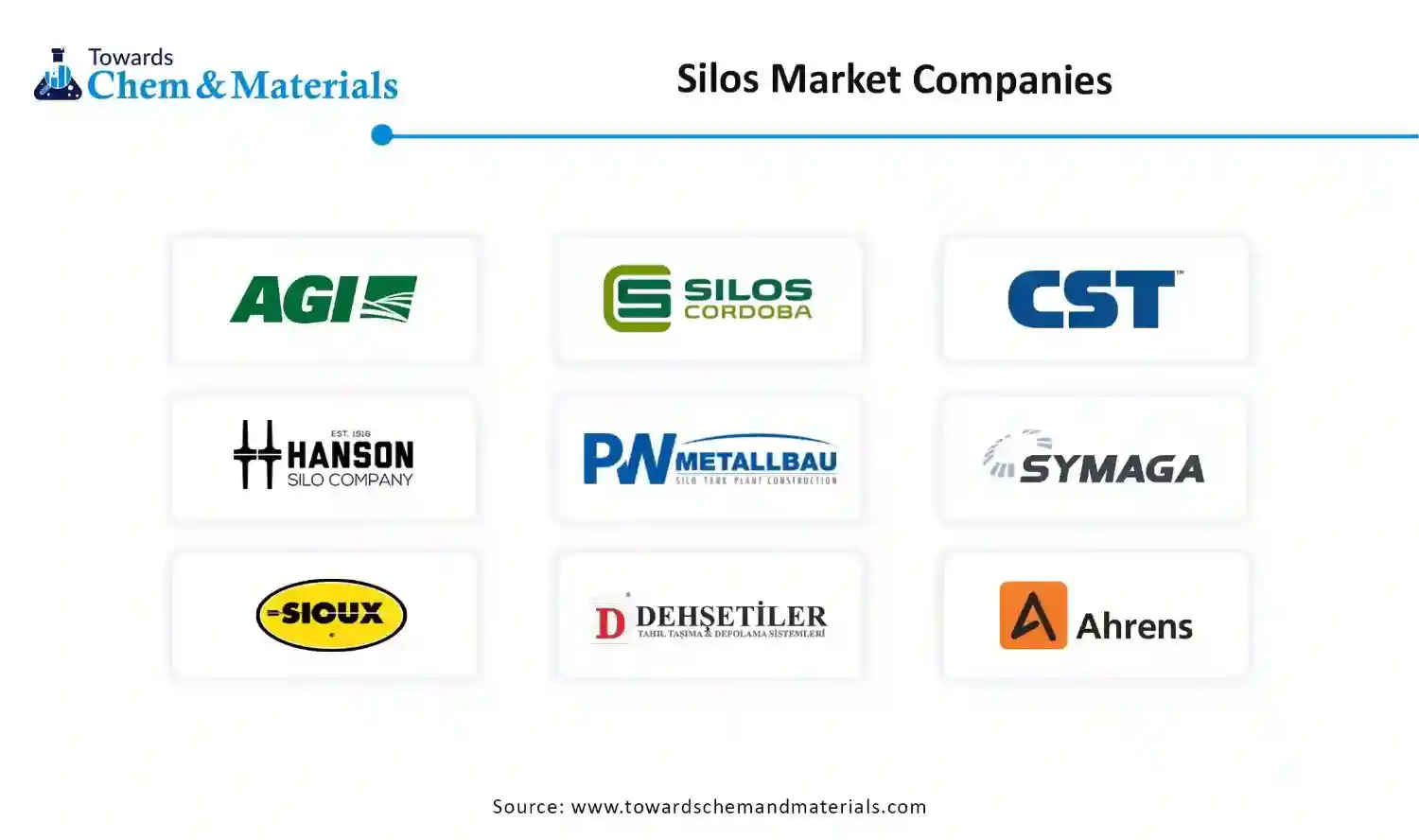November 2025
The global silos market size is calculated at USD 2.99 billion in 2025 and is predicted to increase from USD 3.13 billion in 2026 and is projected to reach around USD 4.80 billion by 2035, The market is expanding at a CAGR of 4.85% between 2025 and 2035. Asia Pacific dominated the silos market with a market share of 40.50% the global market in 2024.The increasing need for bulk material storage in the agriculture sector is set to create competitive advantages in production.

The silos market comprises storage structures designed for bulk materials such as grains, cement, coal, woodchips, and other industrial products. These structures are widely used in agriculture, manufacturing, and construction to support efficient handling, reduce material losses, and protect against moisture. According to the Food and Agriculture Organization’s 2023 assessment, post-harvest losses in cereals can reach up to 14 percent in several developing regions, which has increased demand for modern silo systems that provide better aeration and controlled discharge.
Silos are constructed from steel, concrete, and plastic are available in different configurations, such as tower, bag, and bunker types, depending on capacity and operational needs. OECD and European Commission agricultural data show that grain storage capacity in major producing regions has expanded steadily, with the European Union reporting more than 9 percent growth in on-farm storage construction between 2018 and 2023 due to rising crop output and mechanisation. Similar progress is seen in Asia, where World Bank-supported programs in countries such as India and Vietnam focus on upgrading grain handling and storage infrastructure, reflecting the growing importance of efficient storage systems and supporting long-term market growth.
| Report Attributes | Details |
| Market Size in 2026 | USD 3.13 Billion |
| Expected Size by 2035 | USD 4.80 Billion |
| Growth Rate from 2025 to 2035 | CAGR 4.85% |
| Base Year of Estimation | 2024 |
| Forecast Period | 2026 - 2035 |
| Leading Region | Asia Pacific |
| Segment Covered | By Type, By Material, By Application, By Region |
| Key Companies Profiled | AGI (Ag Growth International), Silos Córdoba, CST Industries, Inc., Hanson Silo Company, P+W Metallbau GmbH & Co. KG, Symaga Group , Sioux Steel Company, Dehsetiler Makina , Ahrens Group , Nelson Silos , Lipp GmbH , Riela GmbH , GE Silos , Kotzur Pty Ltd. , Behlen Mfg. Co. |
Silos are becoming smarter as digital agriculture tools continue to grow globally. Modern systems use sensors to measure temperature, moisture, grain weight, and airflow in real time, which helps prevent losses linked to poor storage conditions. According to the Food and Agriculture Organization’s 2023 estimates, better monitoring technologies can reduce post-harvest cereal losses by up to 30 percent in regions with limited storage management, which makes sensor-based systems increasingly valuable.
These real-time data insights guide farmers on when to aerate, mix, or move stored grain before spoilage occurs. Automatic filling and level control systems also help prevent overfilling, reduce dust emissions, and improve worker safety. The use of advanced coatings and improved surface materials is growing as well, which helps resist corrosion, enhances food safety, and reduces cleaning time for large storage units.
| Country / Region | Regulatory Body | Key Regulations | Focus Areas | Notable Notes |
| United States | Occupational Safety and Health Administration (OSHA) | OSHA Grain Handling Facilities Standard (29 CFR 1910.272) | Preventing catastrophic dust explosions and fires | This is a federal agency that ensures safe and healthy working conditions by setting and enforcing standards for industrial facilities. |
| European Union | European Commission (EC) | ATEX Directives (ATmosphères EXplosibles) | harmonizing safety standards across member states | This is the executive body that initiates and enforces EU-wide legislation on industrial safety and the environment. |
| China | Ministry of Ecology and Environment (MEE) | Law of the People's Republic of China on the Prevention and Control of Environmental Pollution by Solid Waste | Strengthening environmental protection and pollution control | This agency enforces environmental protection laws and monitors pollution from industrial storage facilities.. |
How did the Tower Silos Segment Dominate the Silos Market in 2024?
The tower silos segment dominated the market with a 56.8% industry share in 2024, thanks to their ability to store large volumes in a small footprint. Moreover, several farmers with limited land are actively purchasing tall steel or concrete towers to hold grain vertically in the current period.
On the other hand, the bag silos segment is expected to grow at a significant 5.6% owing to factors such as flexibility, affordability, and faster installation. Moreover, without major building work, the farmers have seen fit to buy bags or bagging machines in the current period. Moreover, the offerings, such as easy to move, seasonal use, and more, have led the bag silos to gain major industry attention in recent years.
The bunker silos segment is also notably growing, in line with the increasing demand for low-cost, high-volume feed storage in the current period. Moreover, for farmers who need wet feed storage, bunker silos have been the ideal option in the past few years. Furthermore, their lower construction costs for bunker silos have driven industry growth today.
Why does the Steel Silos Segment Dominate the Silos Market by Material?
The steel silos segment dominated the market, accounting for 62.3% of industry share in 2024, as steel is strong, durable, and easy to form into large, weatherproof cylinders. Steel silos can be prefabricated and bolted together on site, allowing quick installation for large capacities.
The plastic silos segment is expected to grow rapidly at 5.8% as new polymers are lighter, cheaper, and corrosion-resistant. Plastic panels are easy to transport and install without heavy cranes, making them ideal for remote or small sites. Plastic also reduces contamination risk for food-grade storage and can be molded to include integrated liners or insulation.
The concrete silos segment is also growing rapidly, as several farmers are using traditional concrete silos across various regions. Moreover, the durability and weather resistance of concrete silos have also drawn industry attention in recent years, according to the latest analysis.
How did the Agriculture Segment Dominate the Silos Market in 2024?
The agriculture segment dominated the market with 46.8% market share in 2024, as farms need to store grain, seed, and feed every season. Crops are harvested at specific times but sold year-round, so storage is essential. Large farms, co-ops, and grain traders invest heavily in silos to protect supply and get better prices by timing sales.
On the other hand, the industrial segment is expected to grow rapidly at 5.7% as factories and processing plants expand; they need storage for powders, pellets, chemicals, and raw materials. Industrial silos tie directly to production lines where steady feed rates matter. As manufacturing grows near cities, industries prefer on-site silos to avoid supply delays.
The food processing segment is also notably growing. Food processors use silos to store flour, sugar, oilseeds, and other dry ingredients on a large scale. With more packaged foods and larger bakeries and processors, they need reliable, hygienic storage to avoid contamination and keep production running 24/7. Processors value silos with easy cleaning, gentle handling, and Integrated metering.
The Asia Pacific silos market size was valued at USD 1.21 billion in 2025 and is expected to surpass around USD 1.95 billion by 2035, expanding at a compound annual growth rate (CAGR) of 4.89% over the forecast period from 2025 to 2035. Asia Pacific dominated the silos market with a 40.5 percent industry share, supported by the region’s large farm area, extensive grain processing activity, and high livestock feed demand. The Food and Agriculture Organization reports that Asia produces more than 50 percent of the world’s cereals each year, which creates a strong need for large-capacity storage systems to manage seasonal harvests and reduce post-harvest losses.

Heavy food demand driven by rapid population growth is also expanding the consumer base for silo manufacturers. United Nations demographic data indicates that Asia added more than 40 million people between 2020 and 2023, which continues to increase pressure on grain supply chains and modern storage infrastructure. This rising demand encourages both public and private investment in upgraded storage technology across the region.
China Strengthens Its Lead in the Global Silos Market
China maintained its dominance in the global silos market due to rapid growth in food processing activities and consistently high grain production. According to the Food and Agriculture Organization’s 2023 data, China remains the world’s largest producer of rice and wheat, which creates continuous demand for large-capacity storage systems that can protect grain quality and reduce post-harvest losses.
State-managed grain reserves also play an important role in strengthening the market. Official reports from China’s National Food and Strategic Reserves Administration highlight extensive investments in modern storage upgrades to support national food security goals. These efforts include the replacement of outdated warehouses with steel and concrete silos that offer improved aeration and temperature control.
Europe Silos Market Analysis
Europe is expected to capture a major share of the silos market because of strong governmental support for safer, modern, and low-waste storage systems. The European Commission and national agricultural agencies have increased funding for post-harvest infrastructure, with Eurostat reporting steady growth in grain storage capacity across major producing countries between 2018 and 2023. These initiatives aim to reduce losses and improve food security across the region.
Stricter laws for food safety and quality have also played an important role in driving demand for advanced silos. Regulations under the European Union’s food hygiene and feed safety frameworks require better control of temperature, moisture, and contamination risks during storage. This has encouraged food processors and farmers to upgrade from traditional storage structures to steel and concrete silos that offer improved monitoring and controlled aeration.
Germany Engineers the Future of Smart Silos with Precision and Automation
Germany is expected to emerge as a prominent player in the silos market due to its strong engineering capabilities, precision manufacturing standards, and large food and chemical industries. According to the Federal Statistical Office of Germany, the country remains one of Europe’s largest producers of processed foods and industrial materials, which increases demand for reliable bulk storage systems capable of handling high volumes while maintaining consistent quality control.
The German manufacturing sector has also shown rapid adoption of automation in storage and handling equipment. Many domestic producers are integrating advanced sensors, temperature monitoring systems, and automated loading technologies into modern silo designs, which aligns with Germany’s national focus on Industry 4.0. Reports from the German Engineering Federation indicate steady investment in digital and automated machinery across the agriculture and processing sectors.
North America Silos Market Trends
North America is a notably growing region in the silos market because of rapid modernization and the continued expansion of grain elevator infrastructure. The United States and Canada remain among the world’s largest grain producers, and USDA data show that higher yields in corn, soybeans, and wheat have increased demand for larger, more efficient storage systems across major farming states. This trend has encouraged operators to scale up facility capacity and adopt more advanced storage technologies.
Higher-capacity silos have been in strong demand in recent years as producers aim to reduce harvest bottlenecks and improve post-harvest handling efficiency. Many farming operations are shifting from smaller, traditional structures to steel and concrete silos that can support automated loading, improved airflow, and safer long-term storage conditions. This shift reflects broader efforts to improve supply chain resilience across the region.
Silos Market Share, By Region, 2024 (%)
| Regional | Revenue Share |
| North America | 25.11% |
| Europe | 19.55% |
| Asia Pacific | 40.60% |
| Latin America | 9.65% |
| Middle East and Africa | 5.09% |
Smart Storage Solutions Drive United States Silo Market Growth
The United States is expected to gain a major share of the global silos market due to the continued expansion of commercial farms and the large-scale grain production and trade. USDA data shows that the United States remains one of the world’s top producers of corn, soybeans, and wheat, and this high output requires significant storage capacity to manage harvest volumes and maintain grain quality throughout the year. As farms grow in size and adopt more mechanised operations, demand for modern silo systems continues to rise.
Grain traders, ethanol plants, and feed manufacturers also rely on large silos for storage, blending, and efficient movement of bulk materials. The United States is a leading producer of fuel ethanol, and the industry depends on high-capacity storage to manage corn supply and feedstock flows. This supports strong demand for steel and concrete silos that can withstand heavy usage and operate with consistent performance across the full production cycle. The trend toward farm consolidation and centralised storage has further accelerated the need for integrated silo systems.
Latin America Silos Market Analysis
Latin America is expected to capture a notable share of the silos market because farming across the region is expanding and becoming more commercial. Countries such as Brazil and Argentina remain among the world’s largest producers of soybeans and corn, and FAO data shows that the region consistently accounts for more than 40 percent of global soybean exports. This level of production requires reliable, high capacity storage systems to manage seasonal harvests and reduce post harvest losses.
Large farms and agricultural cooperatives are increasingly adding modern silos to store crops for longer periods and take advantage of favorable market prices. This trend is especially strong in Brazil, where the Ministry of Agriculture has encouraged investment in on-farm storage to reduce dependence on overloaded transport and port infrastructure. As a result, more producers are building steel and concrete silos that support year-round storage and controlled grain quality.
Brazil’s Grain Powerhouse Drives Demand for Modern Storage Solutions
Brazil is expected to emerge as a prominent country for the silos market in the coming years. The country has huge soy and corn harvests that need seasonal storage near ports and processing hubs. Large agribusinesses build big silos and storage terminals to handle export volumes. Brazil also has many local manufacturers making steel silos and mobile systems for farms.

By Type
By Material
By Application
By Region
November 2025
November 2025
November 2025
November 2025